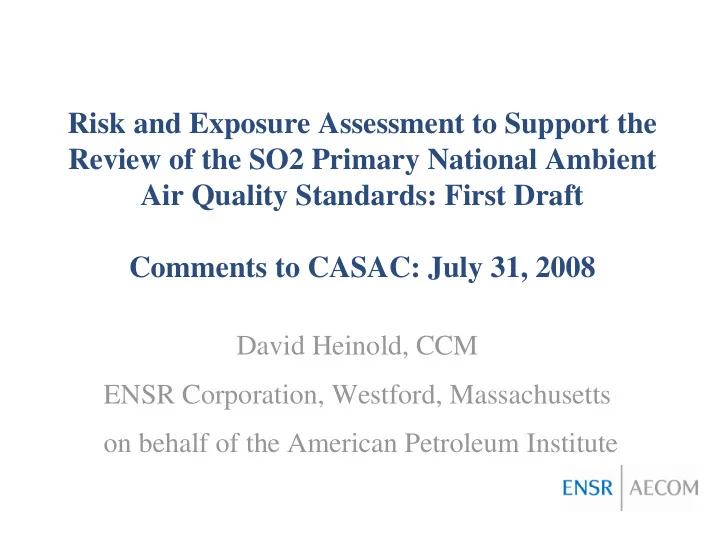

Risk and Exposure Assessment to Support the Review of the SO2 Primary National Ambient Air Quality Standards: First Draft Comments to CASAC: July 31, 2008 David Heinold, CCM ENSR Corporation, Westford, Massachusetts on behalf of the American Petroleum Institute
Estimating 5-Minute Peak Exposures – Short-term fluctuations of SO 2 are highly variable and difficult to estimate – Relation of peak 5-minute concentrations to 1-hour average measurements or modeling depends on: • Spatial distribution of sources • Distances of sources to receptors • Intermittency of emissions • Dispersion environment • Relative contributions from various source types, e.g., �� Point or area �� Elevated or ground level • Atmospheric stability 2
Large Uncertainty in Estimating 5-minute Exposure – Monitoring data indicates a large PMR variability – Peak to Mean Ratio (PMR) statistical model for 5-minute concentrations • Site specific and meteorological PMR factors are not addressed • Overestimation in areas where emissions are widespread • Underestimation for localized sources – Dispersion models not designed or validated for averaging times of less than 1-hour – Short-term emission variations are not well-characterized 3
Method Used to Develop Peak-to-Mean Ratio (PMR) – Based on limited available measurement data • 13 states plus DC had 5-minute data • Most had only peak hourly 5-minute concentration – Statistical PMR Model • Model provides probability distribution for 3 categories of �� hourly Coefficient of Variance (COV) �� 1-hour concentration • Does not account for �� temporal variations in atmospheric turbulence �� source types and distances 4
Evaluation of Just Meeting Current NAAQS – Roll-up Method for Ambient Measurements • Assumes all sources increase proportionately • Mostly limited by 24-hour concentrations • Applies PMR model to estimate 5-minute concentrations • Equivalent benchmark roll-down applied in exposure assessment – Issues • Large extrapolation for most regions because ambient concentrations are well below current NAAQS • Proportionate increase is unlikely �� Just meeting annual standard would probably involve increase in distributed emission sources �� Just meeting 24-hour standard probably involve increase in localized emissions �� National and state programs (e.g., BART) to reduce SO 2 emissions will likely result in even lower future levels 5
Conclusion – Due to the substantial uncertainties in measuring and modeling short-term ambient concentrations, estimating exposure and relating exposure to health effects; the analysis in the REA first draft is insufficiently robust to establish a 5-minute, NAAQS for SO 2 �� Estimation of peak 5-minute concentrations is highly uncertain due to factors that are not addressed in the PMR modeling method �� Current dispersion models are not designed and meteorological as well as emissions data are not available to accurately simulate 5-minute concentration fluctuations �� Methods used to roll-up measurement and modeling data to “just meeting” NAAQS are inherently approximate �� Refinements to the methodology to estimate 5-minute concentrations should be investigated prior to conducting the health assessment 6
Recommend
More recommend